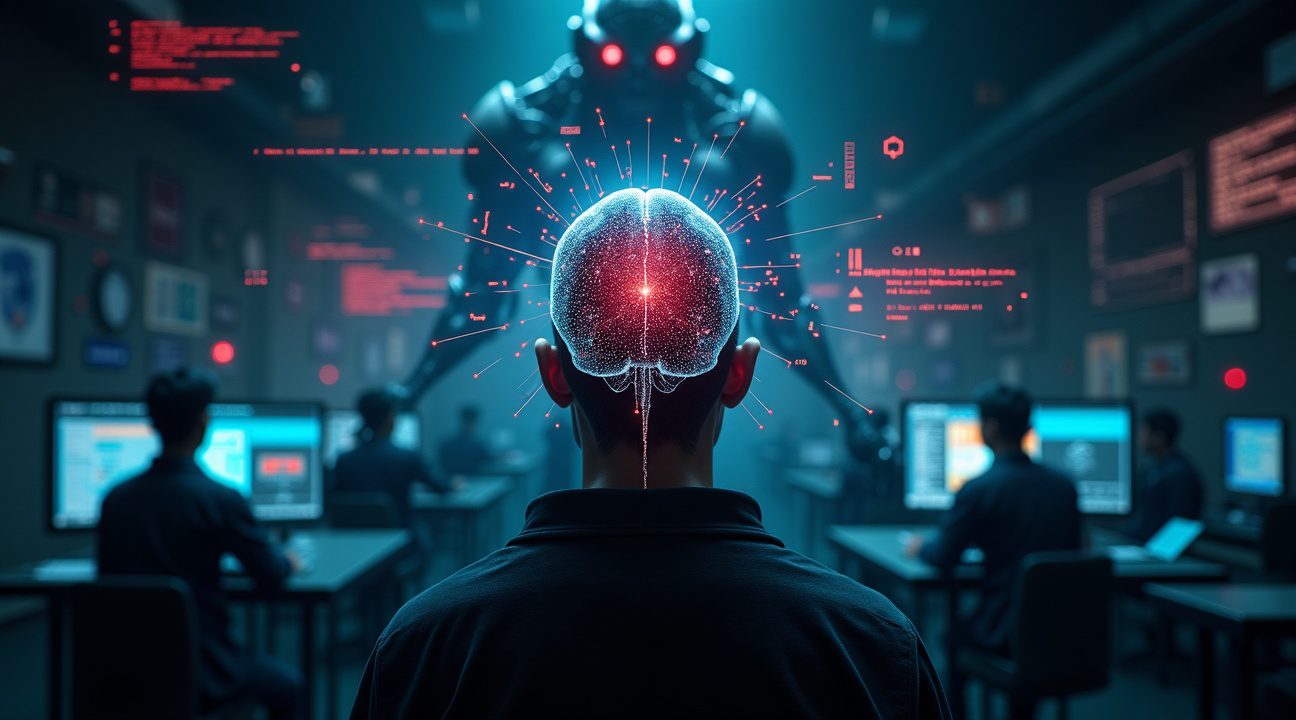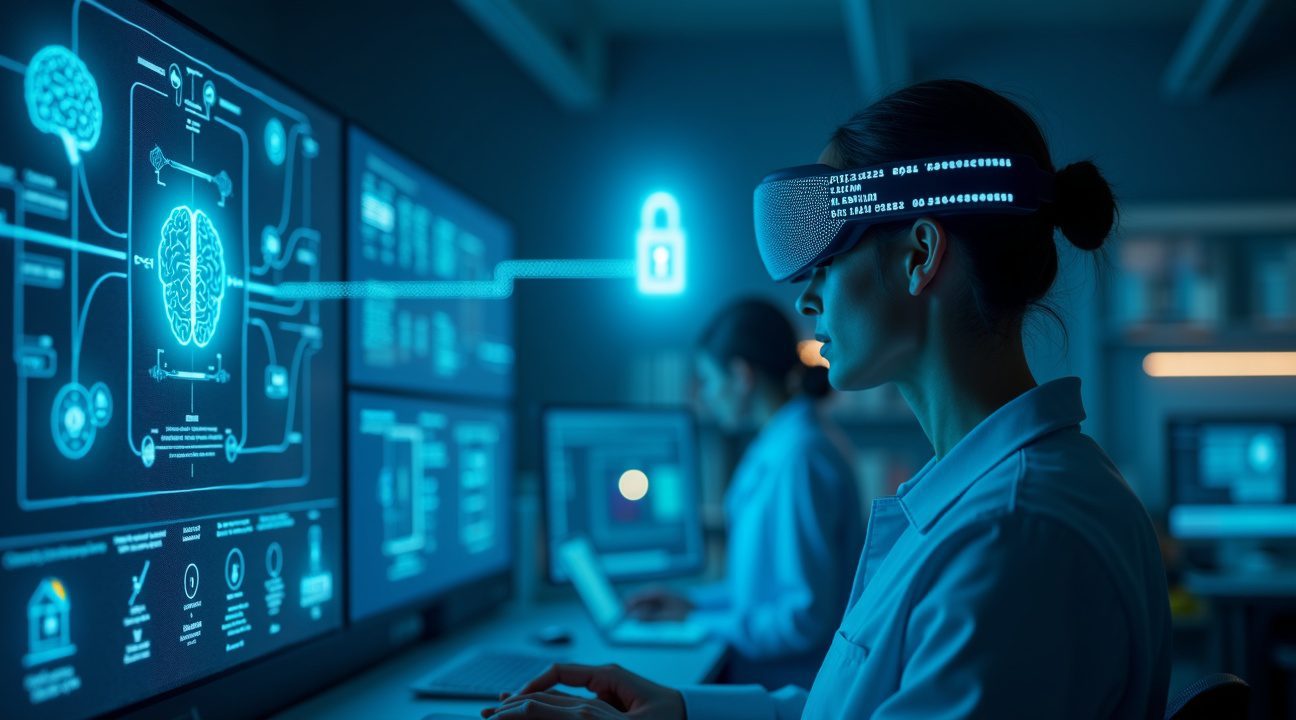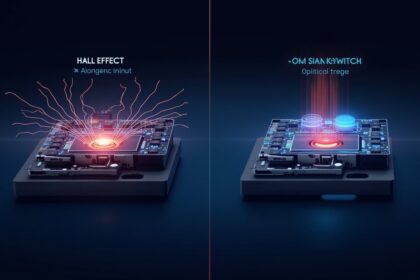Brain-computer interfaces transform communication for paralyzed patients by directly converting neural signals into speech with up to 90% accuracy. This breakthrough technology also creates unprecedented risks to mental privacy as these devices can decode involuntary thoughts, emotions, and subconscious reactions. Current legal frameworks fail to adequately protect neural data, leaving patients vulnerable to cybersecurity threats, commercial exploitation, and potential mental manipulation while regulatory gaps persist across federal and state jurisdictions.
Key Takeaways
- Brain implants can translate thoughts into speech with remarkable precision, offering life-changing communication abilities for patients with ALS, locked-in syndrome, and stroke-related paralysis through vocabularies exceeding 1,000 words.
- Neural devices capture far more than intended commands, revealing subconscious thoughts, emotional states, and cognitive patterns that individuals cannot consciously control or filter, creating the “last privacy frontier.”
- Cybersecurity vulnerabilities expose patients to unprecedented risks including neural hacking, data theft, and potential mental manipulation through compromised brain-computer interfaces that lack adequate protection protocols.
- Current privacy laws including HIPAA provide insufficient coverage for neural data, particularly from consumer neurotech devices, creating regulatory gaps that leave brain information largely unprotected from commercial exploitation.
- Comprehensive security frameworks emphasizing user control, encrypted communications, transparent governance, and patient-centered decision-making are essential to protect mental privacy while preserving the therapeutic benefits of brain-computer interfaces.
The Promise of Neural Communication Technology
Brain-computer interfaces represent a remarkable advancement in medical technology. These devices bypass damaged neural pathways and restore communication abilities for patients who have lost their voice due to neurological conditions. The technology works by implanting electrodes directly into motor cortex regions responsible for speech production.
Stanford University researchers achieved groundbreaking results with a patient who had suffered a brainstem stroke. The system decoded her attempted speech at 62 words per minute with 90% accuracy. These results demonstrate the incredible potential for restoring natural communication patterns.
The technology benefits extend beyond basic word formation. Patients can express complex emotions, engage in detailed conversations, and maintain meaningful relationships. This capability transforms quality of life for individuals with conditions like amyotrophic lateral sclerosis (ALS), locked-in syndrome, and severe spinal cord injuries.
Clinical trials continue expanding vocabulary sizes and improving accuracy rates. Recent studies show systems can handle vocabularies exceeding 1,000 words while maintaining high precision. The speed of communication approaches natural speech patterns, making conversations feel more natural and spontaneous.
The Hidden Depth of Neural Data Collection
Brain-computer interfaces collect far more information than patients intend to share. These devices continuously monitor neural activity, capturing data streams that reveal intimate details about mental states, emotional responses, and cognitive processes.
The technology reads neural signals at the cellular level. Electrode arrays detect action potentials from individual neurons and local field potentials from neural networks. This granular data contains patterns that correlate with specific thoughts, memories, and emotional states.
Researchers can identify when patients feel frustrated, anxious, or excited based on neural signatures. The devices also capture attempts at censoring thoughts or controlling emotional responses. This information remains largely beyond conscious control, making it impossible for patients to filter their mental privacy.
Machine learning algorithms analyze these neural patterns to extract meaning. Advanced artificial intelligence systems can predict intentions before patients fully form conscious thoughts. This predictive capability raises profound questions about mental autonomy and cognitive liberty.
The temporal resolution of neural recording adds another layer of complexity. Devices sample brain activity thousands of times per second, creating detailed timelines of mental processes. This data reveals how thoughts develop, how decisions form, and how emotions influence cognitive functions.
Cybersecurity Vulnerabilities in Brain Interfaces
Neural devices face unique cybersecurity challenges that extend far beyond traditional medical device security. These systems create direct pathways into the human brain, making them attractive targets for malicious actors seeking to exploit or manipulate neural data.
Current brain-computer interfaces often lack basic security protocols. Many devices transmit data wirelessly without proper encryption, making them vulnerable to interception. Hackers could potentially access real-time brain data or inject false signals into the system.
The consequences of neural cyberattacks differ significantly from typical data breaches. Attackers could potentially alter a patient’s perceived reality, inject false memories, or manipulate emotional states. These attacks target the fundamental nature of human consciousness and identity.
Device manufacturers often prioritize functionality over security during development. The rush to bring life-saving technology to market sometimes results in inadequate security testing and implementation. This approach leaves patients exposed to risks that may not manifest until years after implantation.
Software vulnerabilities present ongoing risks throughout the device lifetime. Brain implants typically remain functional for decades, but security patches and updates may be limited or impossible to implement safely. This creates long-term exposure windows for emerging attack vectors.
Legal and Regulatory Gaps
Current privacy laws fail to address the unique characteristics of neural data. The Health Insurance Portability and Accountability Act (HIPAA) covers medical information but doesn’t specifically protect brain data from commercial exploitation or unauthorized access.
Consumer neurotech devices often fall outside medical device regulations entirely. Companies developing brain-training apps, meditation devices, and cognitive enhancement tools can collect and monetize neural data with minimal oversight. This regulatory gap leaves consumers vulnerable to privacy violations.
State and federal jurisdictions create a patchwork of conflicting regulations. Some states have begun developing neural rights legislation, while others provide no specific protections. This inconsistency makes it difficult for patients and companies to understand their rights and obligations.
International data transfers add another layer of complexity. Neural data collected in one country may be processed or stored in nations with different privacy standards. Patients have little visibility into where their brain data travels or how foreign entities might use it.
The definition of neural data remains unclear in legal contexts. Courts haven’t established whether brain signals constitute private thoughts, medical information, or behavioral data. This ambiguity makes it difficult to apply existing privacy frameworks effectively.
Building Comprehensive Protection Frameworks
Effective neural privacy protection requires multilayered security approaches that address technical, legal, and ethical dimensions. These frameworks must balance patient safety with innovation while establishing clear boundaries for data collection and use.
Patient control represents the foundation of neural privacy protection. Individuals should maintain decision-making authority over their brain data, including collection, processing, sharing, and deletion rights. This control extends to posthumous data handling and inheritance considerations.
Technical security measures must evolve to match the sensitivity of neural information. Encryption protocols should protect data both in transit and at rest. Hardware security modules can safeguard cryptographic keys and prevent unauthorized device access.
Transparency requirements should mandate clear disclosure of data collection practices. Patients deserve detailed information about what neural signals devices capture, how algorithms process this information, and who has access to the resulting data. Regular audits can verify compliance with disclosure requirements.
Governance structures should include patient advocacy groups, ethicists, and privacy experts alongside technical developers. This inclusive approach ensures that protection frameworks address real-world concerns rather than theoretical scenarios.
Research and development practices must integrate privacy-by-design principles from the earliest stages. Security considerations should influence device architecture, data processing algorithms, and user interface design. Retroactive privacy protections prove less effective than proactive security implementations.
The Path Forward
Brain-computer interfaces will continue advancing rapidly, making neural privacy protection increasingly urgent. The scientific community must develop standards that protect mental privacy while preserving the therapeutic benefits of these remarkable technologies.
Industry collaboration can accelerate the development of security best practices. Device manufacturers, software developers, and healthcare providers should work together to establish common security standards and share threat intelligence. This cooperation benefits all stakeholders by improving overall ecosystem security.
Educational initiatives should help patients understand the privacy implications of neural devices. Informed consent processes must clearly explain data collection practices, potential risks, and available protections. Patients need practical guidance for making decisions about their neural privacy.
Regulatory agencies should engage proactively with emerging neural technologies. Waiting for privacy violations to occur before implementing protections leaves patients vulnerable during critical early adoption periods. Adaptive regulatory frameworks can evolve alongside technological developments.
The stakes of neural privacy protection extend beyond individual patients. These technologies have the potential to fundamentally alter human communication, cognition, and social interaction. Getting the privacy framework right ensures that brain-computer interfaces enhance rather than compromise human autonomy and dignity.
Success requires sustained commitment from all stakeholders. Researchers, clinicians, industry leaders, policymakers, and patients must work together to create a future where neural technologies unlock human potential without sacrificing mental privacy. The choices made today will shape the neurotechnology landscape for generations to come.
Revolutionary Brain Implants Help Paralyzed Patients Speak Through Their Thoughts
Brain-computer interfaces have transformed how patients with severe communication disorders reconnect with the world around them. These sophisticated devices decode neural signals directly from the brain, converting thoughts and intentions into understandable language, movement commands, or gestures. I’ve observed how this technology offers unprecedented hope for individuals who’ve lost their ability to speak due to paralysis or neurological conditions.
Breakthrough Technology for Speech-Impaired Patients
The most recent advances in artificial intelligence have enabled BCIs to interpret inner speech patterns with remarkable precision. Patients with ALS, locked-in syndrome, or stroke-related paralysis now have access to communication methods that were unimaginable just a decade ago. Advanced systems can translate brain signals into speech with vocabularies exceeding 1000 words, providing users with substantial expressive capabilities.
Stanford’s speech prosthesis represents a pinnacle achievement in this field, directly converting brain activity into text or synthesized voice output. Under experimental conditions, state-of-the-art BCIs achieve accuracy rates reaching 90% for full sentence translation in specific patient populations. This level of precision allows for meaningful real-time conversations between patients and their caregivers, family members, or medical professionals.
Invasive vs. Non-Invasive Approaches
Two distinct technological pathways have emerged for brain-computer communication:
- Invasive implants require neurosurgical procedures to place electrodes directly on or within brain tissue.
- Non-invasive devices like EEG headsets monitor neural activity from outside the skull.
Currently, invasive approaches deliver superior signal fidelity and more dependable communication capabilities.
The enhanced performance of surgically implanted devices stems from their direct access to neural signals without interference from skull bone and tissue. These systems capture cleaner, more precise electrical patterns from neurons responsible for speech and motor planning. Non-invasive alternatives, while safer and more accessible, face limitations in signal clarity that can affect communication accuracy and speed.
Patients considering BCI technology must weigh the surgical risks of invasive systems against their superior performance capabilities. For individuals with progressive conditions like ALS, the enhanced communication potential of implanted devices often justifies the procedural requirements. Healthcare teams work closely with patients to determine the most appropriate approach based on their specific medical circumstances, communication needs, and long-term prognosis.
The technology continues advancing rapidly, with researchers developing more sophisticated algorithms for neural signal interpretation and improving hardware designs for better biocompatibility and longevity.

Your Neural Data Reveals More Than You Think: The Privacy Risks of Reading Minds
Neural data exposes far more than intended speech commands. Brain signals reveal a comprehensive map of mental activity, including subconscious thoughts, emotional states, and even indicators of future cognitive decline. I can’t stress enough how different this is from traditional privacy concerns—while someone might choose to share their location or browsing habits, neural data captures information that individuals themselves don’t consciously know they’re revealing.
Mental privacy represents what experts call the ‘last privacy frontier‘ because artificial intelligence can now decode involuntary brain processes that were previously hidden from external observation. Brain implants don’t just read deliberate thoughts; they pick up mental imagery, emotional responses, and subconscious reactions that occur without conscious control. This creates an unprecedented vulnerability where private mental experiences become accessible to external systems.
The Commercial Threat to Mental Privacy
Consumer-grade neurotech companies pose significant risks to neural privacy. The Neurorights Foundation’s 2024 report revealed that numerous companies accessing consumer neural data provided no meaningful limitations on how they use this information. Companies could potentially stream or store brain signals for analysis, creating vast databases of the most intimate human data imaginable.
The implications extend far beyond individual privacy violations. Neural data analysis could enable:
- Political manipulation by identifying psychological vulnerabilities
- Workplace discrimination based on cognitive patterns
- Commercial exploitation through targeted mental influence
Unlike GPS tracking or search history, neural signals reveal information about mental processes that individuals cannot control or consciously filter.
Technology platforms are already converging neural interfaces with other biometric systems. Apple Vision Pro combines eye tracking with spatial computing, while Meta develops neural bands that could integrate with existing social platforms. These systems blur the boundaries between mental privacy and broader biometric surveillance, creating comprehensive profiles of human behavior and cognition.
The involuntary nature of neural data collection makes traditional consent models inadequate. Brain signals continuously generate information about mental states, health conditions, and cognitive function—data that individuals cannot choose to withhold once a neural interface is active. This represents a fundamental shift from privacy models based on voluntary data sharing to systems that capture the most private aspects of human experience without conscious control.
Smart glasses and similar devices demonstrate how quickly invasive technologies can become mainstream consumer products. Neural interfaces follow a similar trajectory, but with far greater implications for human autonomy and mental freedom. Protecting neural privacy requires recognizing that brain data isn’t just another form of personal information—it’s the foundation of human consciousness itself.
Hackers Could Take Control of Your Brain Implant: Cybersecurity Threats to Neural Devices
I find the prospect of neural hacking particularly alarming given how vulnerable current brain-computer interfaces (BCIs) are to cyberattacks. Modern BCIs face serious risks from manipulation via malicious AI systems, creating scenarios where hackers could potentially control someone’s thoughts or actions. Researchers have already demonstrated how artificial intelligence can send harmful commands directly to implanted devices, resulting in unwanted device actions or severe breaches of mental privacy.
The cybersecurity landscape for neural devices presents unique challenges that traditional medical device protection doesn’t address. Unlike standard implants, BCIs create direct pathways into the brain’s electrical activity, making them attractive targets for sophisticated attacks. Malicious actors could exploit these vulnerabilities to steal neural data, manipulate device functions, or even influence a person’s decision-making processes.
Legal Gaps Leave Neural Data Unprotected
Current privacy protections fall dangerously short when it comes to neural information. Most existing laws, including HIPAA and state legislation, often exclude BCIs and consumer neurotech devices from their coverage. This regulatory gap means that neural data receives much weaker protection than other forms of personal health information, despite being arguably more sensitive and personal.
The absence of comprehensive legal frameworks creates several critical vulnerabilities:
- Neural data can be collected, stored, and shared without the same consent requirements as traditional medical information
- Device manufacturers face fewer restrictions on how they handle brain activity patterns and thought data
- Law enforcement agencies may access neural information through legal loopholes not present for other health records
- Third-party companies can potentially purchase or access neural datasets for commercial purposes
- Cross-border data transfers of brain information often lack adequate protection mechanisms
Smart glasses and other consumer neurotech devices compound these privacy concerns by operating outside medical oversight entirely. Users might unknowingly share neural patterns with technology companies that have few restrictions on data usage.
A comprehensive Yale study identified specific security measures needed to protect neural devices from cyberthreats. The research recommends implementing encrypted data transfers for all neural information, ensuring that brain activity patterns remain protected during transmission between devices and external systems. Strong authentication protocols for software updates represent another critical defense, preventing unauthorized parties from installing malicious code on neural implants.
Training AI models to resist adversarial attacks on BCIs emerges as perhaps the most crucial recommendation. These defensive AI systems could recognize and block attempts to manipulate neural devices through corrupted data inputs or malicious commands. However, developing such protective measures requires significant investment and coordination between neurotechnology companies, cybersecurity experts, and regulatory bodies.
Cybersecurity vulnerabilities in neural devices expose patients to unprecedented risks that extend far beyond traditional privacy concerns. Mental manipulation through compromised BCIs could affect personality, decision-making, memory formation, and even fundamental aspects of consciousness. Data theft from neural implants provides attackers with intimate knowledge of a person’s thoughts, emotions, and mental processes.
The potential for neural hacking raises questions about autonomy and free will that society hasn’t faced before. If someone’s brain implant gets compromised, distinguishing between their authentic thoughts and artificially influenced ones becomes nearly impossible. This scenario creates legal, ethical, and personal identity challenges that current frameworks can’t adequately address.
Device security for neural implants requires constant vigilance and updates, similar to how artificial intelligence systems need ongoing monitoring for potential misuse. Manufacturers must implement robust security protocols from the design phase, rather than treating cybersecurity as an afterthought. Regular security audits, penetration testing, and vulnerability assessments become essential components of neural device maintenance.
The race between neural technology advancement and cybersecurity development will likely determine whether brain implants remain beneficial medical tools or become dangerous vulnerabilities. Patients considering neural implants must weigh potential therapeutic benefits against very real risks of mental privacy invasion and cognitive manipulation.
https://www.youtube.com/watch?v=RSfP8sXtMbk

The Legal Wild West: Why Neural Data Privacy Laws Can’t Keep Up
I’ve watched the neurotech industry explode while privacy regulations stumble far behind. The legal landscape for protecting neural data remains a fragmented mess, with incomplete coverage that leaves massive gaps in mental privacy protection.
Most existing privacy laws, including HIPAA and state consumer protection statutes, only shield neural data when medical entities process it. This approach leaves neurotech device manufacturers and consumer platforms operating in an unregulated space. Patients using medical brain implants receive some protection, but consumers experimenting with commercial smart glasses or other neural interfaces face minimal legal safeguards.
States have begun crafting their own solutions, creating a patchwork of inconsistent rules. California and Colorado have proposed or enacted legislation treating neural data as uniquely sensitive information requiring special protection. Each state’s approach differs significantly, forcing manufacturers to navigate conflicting compliance requirements across multiple jurisdictions.
Federal Inaction Despite Growing Concerns
U.S. Senators recognized the urgency in April 2025, urging the Federal Trade Commission to protect neural data from exploitation and unauthorized sale. Despite these congressional appeals, federal action remains absent as of late 2025. The FTC hasn’t issued comprehensive guidelines or enforcement actions addressing neural privacy concerns.
This federal vacuum creates uncertainty for both companies and consumers. Manufacturers struggle with compliance challenges as states develop incompatible regulatory frameworks. Some require explicit consent for neural data collection, while others focus on data storage limitations or usage restrictions.
The World Economic Forum and academic experts propose a broader approach to mental privacy protection. They argue regulations should safeguard inferences about mental and health states regardless of data source—whether derived from neural sensors, biometric monitoring, or other technologies. This perspective recognizes that artificial intelligence can extract sensitive mental insights from seemingly innocuous data streams.
Consumer neurotech devices present particular challenges since they don’t fall under traditional medical oversight. These products collect neural signals for gaming, meditation, or productivity enhancement, yet users have little legal recourse if companies misuse their brain data. Current consumer protection laws weren’t designed for technologies that literally read minds.
The regulatory gap grows more concerning as neural technologies advance rapidly. Brain-computer interfaces capable of decoding complex thoughts will soon reach consumer markets, but legal frameworks lag years behind technological capabilities. Without comprehensive federal legislation, mental privacy protection remains inconsistent and inadequate across the country.

Brain Privacy as a Human Right: The Fight for Freedom of Thought
Mental privacy represents one of the most fundamental human rights, standing alongside freedom of thought and personal dignity. When neural implants can decode inner thoughts, they potentially violate international protections for thought and conscience that have existed for centuries. I find this intersection between cutting-edge neurotechnology and basic human rights particularly striking.
The implications extend far beyond medical applications. Smart glasses and other consumer devices increasingly incorporate sensors that could potentially infer mental states through indirect means. This technological convergence means that mental privacy risks aren’t confined to surgical brain implants anymore.
Essential Ethical Frameworks for Neural Protection
Modern ethical frameworks for neurotechnology center on three critical principles that I believe should guide development:
- User agency ensures individuals maintain complete control over their neural data, including access, sharing, and deletion rights
- Data solidarity requires that benefits from neural research and applications be distributed fairly across communities rather than concentrated among tech companies
- Precautionary approaches demand thorough safety testing and harm prevention before widespread adoption of brain-reading technologies
These frameworks recognize that artificial intelligence systems processing neural data could make inferences about personality, emotions, and intentions that individuals never consented to share. Regulatory thought leaders increasingly advocate for technology-neutral privacy protections that guard against unauthorized mental state inference from any type of sensor data.
The challenge grows more complex as platforms integrate multiple data streams. Eye tracking, facial recognition, voice analysis, and biometric sensors can collectively paint detailed pictures of mental states without direct brain access. I see this convergence making comprehensive privacy protections more urgent than ever.
Advocacy efforts focus on establishing legal frameworks that treat mental privacy as inalienable. Some propose constitutional amendments specifically protecting neural data, while others push for international treaties governing brain-computer interfaces. The goal remains consistent: ensuring that technological advancement doesn’t erode the sanctity of human thought.
The stakes couldn’t be higher. Once society accepts that thoughts can be accessed and analyzed without explicit consent, the fundamental nature of human autonomy changes. Mental privacy advocates argue that protecting freedom of thought requires proactive legislation rather than reactive responses to privacy violations. This approach recognizes that some technological capabilities, once developed and deployed, become nearly impossible to contain or regulate effectively.

Protecting Your Mind: Security Solutions for the Neural Age
Brain-computer interfaces demand comprehensive security frameworks that prioritize patient autonomy while preventing unauthorized access to neural data. I’ve examined the emerging best practices that address both technical vulnerabilities and ethical concerns surrounding these powerful devices.
Essential Security Protocols for Neural Devices
Robust encryption forms the foundation of neural security, protecting the intimate connection between brain and machine. The Yale Digital Ethics Center emphasizes several critical safeguards that developers must implement:
- Non-surgical device updates allow for security patches without invasive procedures.
- Encrypted communication channels prevent interception of neural signals.
- Authenticated software changes ensure only verified updates reach the device.
- Carefully managed device permissions restrict what actions AI systems can perform based on brain signals.
Patient control represents another cornerstone of neural security. Users must retain direct authority over which neural actions trigger device responses, creating a clear boundary between involuntary thoughts and intentional commands. This approach prevents the misinterpretation of casual mental activity as deliberate instructions.
Governance and Regulatory Frameworks
Effective neurotechnology governance requires transparent policies that clearly define data usage limitations and accountability measures. Organizations developing brain-computer interfaces should implement strict controls on neural data trading, with many experts recommending outright bans on commercial exploitation of thought patterns.
Regulatory models vary significantly in their approach to balancing innovation with protection:
- Some frameworks emphasize data solidarity, where collective benefit guides neural data usage policies.
- Others focus on market-driven approaches that may prioritize commercial interests over individual privacy rights.
Studies comparing these models consistently favor patient-centered governance structures that involve users directly in ethical decision-making processes.
User transparency emerges as a critical component across all regulatory frameworks. Patients must understand exactly how their neural data gets processed, stored, and potentially shared. This includes clear documentation of which thoughts or intentions might trigger device actions and comprehensive disclosure of any smart device integrations.
The implementation of these security measures requires ongoing collaboration between technologists, ethicists, and patients themselves. Regular security audits, updated encryption protocols, and evolving governance structures will help ensure that brain-computer interfaces enhance human capabilities without compromising mental privacy. As these technologies advance, maintaining this delicate balance between functionality and security becomes increasingly crucial for widespread adoption and patient trust.

Sources:
Nature – “Brain-computer interface restores speech in people with paralysis”
The Record – “Brain implant breakthrough raises concerns about neural data privacy”
Yale News – “Yale study offers measures for safeguarding brain implants”
World Economic Forum – “Beyond neural data: protecting privacy across technologies”
Arnold & Porter – “Neural Data Privacy Regulation: The Law and Its Limitations”
Science – “Brain device reads inner thoughts aloud, inspires strategies to protect mental privacy”
VeraSafe – “Mental Privacy in Neurotech and the Growing Risk for Organizations”
New America (Open Technology Institute) – “The Rise of Neurotech and the Risks for Our Brain Data”


